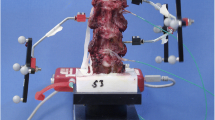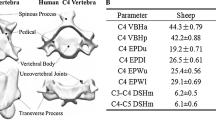Abstract
Pre-clinical in vitro tests are needed to evaluate the biomechanical performance of new spinal implants. For such experiments large animal models are frequently used. Whether these models allow any conclusions concerning the implant’s performance in humans is difficult to answer. The aim of the present study was to investigate whether calf, pig or sheep spine specimens may be used to replace human specimens in in vitro flexibility and cyclic loading tests with two different implant types. First, a dynamic and a rigid fixator were tested using six human, six calf, six pig and six sheep thoracolumbar spine specimens. Standard flexibility tests were carried out in a spine tester in flexion/extension, lateral bending and axial rotation in the intact state, after nucleotomy and after implantation. Then, the Coflex interspinous implant was tested for flexibility and intradiscal pressure using another six human and six calf lumbar spine segments. Loading was carried out as described above in the intact condition, after creation of a defect and after implantation. The fixators were most easily implantable into the calf. Qualitatively, they had similar effects on ROM in all species, however, the degree of stability achieved differed. Especially in axial rotation, the ROM of sheep, pig and calf was partially less than half the human ROM. Similarly, implantation of the Coflex interspinous implant caused the ROM to either increase in both species or to decrease in both of them, however, quantitatively, differences were observed. This was also the case for the intradiscal pressure. In conclusion, animal species, especially the calf, may be used to get a first idea of how a new pedicle screw system or an interspinous implant behaves in in vitro flexibility tests. However, the effects on ROM and intradiscal pressure have to be expected to differ in magnitude between animal and human. Therefore, the last step in pre-clinical implant testing should always be an experiment with human specimens.







Similar content being viewed by others
References
Abe E, Nickel T, Buttermann GR, Lewis JL, Transfeldt EE (1999) The effect of spinal instrumentation on lumbar intradiscal pressure. Tohoku J Exp Med 187(3):237–247
Adams MA, Bogduk N, Burton K, Dolan P (2002) The biomechanics of back pain. Churchill Livingstone, Edinburgh
An HS, Singh K, Vaccaro AR, Wang G, Yoshida H, Eck J, McGrady L, Lim TH (2004) Biomechanical evaluation of contemporary posterior spinal internal fixation configurations in an unstable burst-fracture calf spine model: special references of hook configurations and pedicle screws. Spine 29(3):257–262
Brodke DS, Bachus KN, Mohr RA, Nguyen BK (2001) Segmental pedicle screw fixation or cross-links in multilevel lumbar constructs. A biomechanical analysis. Spine J 1(5):373–379
Cotterill PC, Kostuik JP, D’Angelo G, Fernie GR, Maki BE (1986) An anatomical comparison of the human and bovine thoracolumbar spine. J Orthop Res 4:298–303
Dick JC, Jones MP, Zdeblick TA, Kunz DN, Horton WC (1994) A biomechanical comparison evaluating the use of intermediate screws and cross-linkage in lumbar pedicle fixation. J Spinal Disord 7(5):402–407
Kettler A, Wilke HJ, Haid C, Claes L (2000) Effects of specimen length on the monosegmental motion behavior of the lumbar spine. Spine 25(5):543–550
Lee SH, Derby R, Chen Y, Seo KS, Kim MJ (2004) In vitro measurement of pressure in intervertebral discs and annulus fibrosus with and without annular tears during discography. Spine J 4(6):614–618
Lim TH, Kim JG, Fujiwara A, Yoon TT, Lee SC, Ha JW, An HS (2001) Biomechanical evaluation of diagonal fixation in pedicle screw instrumentation. Spine 26(22):2498–2503
McNally DS, Adams MA (1992) Internal intervertebral disc mechanics as revealed by stress profilometry. Spine 17(1):66–73
Nohara H, Kanaya F (2004) Biomechanical study of adjacent intervertebral motion after lumbar spinal fusion and flexible stabilization using polyethylene-terephthalate bands. J Spinal Disord Tech 17(3):215–219
Park C, Kim YJ, Lee CS, An K, Shin HJ, Lee CH, Kim CH, Shin JW (2005) An in vitro animal study of the biomechanical responses of anulus fibrosus with aging. Spine 30(10):E259–E265
Rao RD, David KS, Wang M (2005) Biomechanical changes at adjacent segments following anterior lumbar interbody fusion using tapered cages. Spine 30(24):2772–2776
Rao RD, Wang M, Singhal P, McGrady LM, Rao S (2002) Intradiscal pressure and kinematic behavior of lumbar spine after bilateral laminotomy and laminectomy. Spine J 2(5):320–326
Riley LH 3rd, Eck JC, Yoshida H, Koh YD, You JW, Lim TH (2004) A biomechanical comparison of calf versus cadaver lumbar spine models. Spine 29(11):E217–E220
Schmidt R, Richter M, Claes L, Puhl W, Wilke HJ (2005) Limitations of the cervical porcine spine in evaluating spinal implants in comparison with human cervical spinal segments: a biomechanical in vitro comparison of porcine and human cervical spine specimens with different instrumentation techniques. Spine 30(11):1275–1282
Scifert JL, Sairyo K, Goel VK, Grobler LJ, Grosland NM, Spratt KF, Chesmel KD (1999) Stability analysis of an enhanced load sharing posterior fixation device and its equivalent conventional device in a calf spine model. Spine 24(21):2206–2213
Sudo H, Oda I, Abumi K, Ito M, Kotani Y, Hojo Y, Minami A (2003) In vitro biomechanical effects of reconstruction on adjacent motion segment: comparison of aligned/kyphotic posterolateral fusion with aligned posterior lumbar interbody fusion/posterolateral fusion. J Neurosurg 99(2 Suppl):221–228
Wilke HJ, Claes L, Schmitt H, Wolf S (1994) A universal spine tester for in vitro experiments with muscle force simulation. Eur Spine J 3(2):91–97
Wilke HJ, Kettler A, Claes LE (1997) Are sheep spines a valid biomechanical model for human spines? Spine 22(20):2365–2374
Wilke HJ, Kettler A, Wenger KH, Claes LE (1997) Anatomy of the sheep spine and its comparison to the human spine. Anat Rec 247(4):542–555
Wilke HJ, Krischak ST, Wenger KH, Claes LE (1997) Load-displacement properties of the thoracolumbar calf spine: experimental results and comparison to known human data. Eur Spine J 6(2):129–137
Wilke HJ, Wenger K, Claes L (1998) Testing criteria for spinal implants: recommendations for the standardization of in vitro stability testing of spinal implants. Eur Spine J 7(2):148–154
Acknowledgments
This work was supported by AOSpine. The implants were provided by Ulrich medical (Ulm, Germany) and Paradigm Spine (Wurmlingen, Germany).
Author information
Authors and Affiliations
Corresponding author
Rights and permissions
About this article
Cite this article
Kettler, A., Liakos, L., Haegele, B. et al. Are the spines of calf, pig and sheep suitable models for pre-clinical implant tests?. Eur Spine J 16, 2186–2192 (2007). https://doi.org/10.1007/s00586-007-0485-9
Received:
Revised:
Accepted:
Published:
Issue Date:
DOI: https://doi.org/10.1007/s00586-007-0485-9




